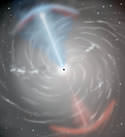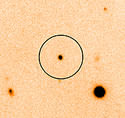
Image credit: Gemini
The Gemini Observatory located on top of Hawaii’s Mauna Kea has been used to create an animation of the action going on in galaxy NGC 1068. Using a tool called the Integral Field Unit, astronomers have been able to create a 3-dimensional animation of the tremendous jet emanating from the supermassive black hole as it slams into the galactic gas disk.
Astronomers observing with the Gemini North Telescope on Hawaii’s Mauna Kea have a powerful new tool to probe mysterious cosmic caldrons like those at the cores of galaxies and stellar nurseries.
Using the recently commissioned Integral Field Unit (IFU) on the Gemini Multi-Object Spectrograph (GMOS), astronomers at the observatory have recently obtained a complete multi-dimensional picture of the dynamic flow of gas and stars at the core of an active galaxy named NGC 1068 in a single snap-shot. The resulting windfall of data has been transformed into an animation that dramatically reveals the internal gyrations of the galaxy – including the interactions of a pair of galactic-scale jets that spew material for thousands of light years away from the suspected black hole at the galaxy’s core.
“The Gemini data of NGC 1068 reveal one of the lesser know features of galaxy jets,” explains Gemini North Associate Director Dr. Jean-Ren? Roy. “For the first time we were able to clearly see the jet’s expanding lobe as its hypersonic bow shock slams directly into the underlying gas disk of the galaxy. It’s like a huge wave smashing onto a galactic shoreline.”
Dr. Gerald Cecil of the University of North Carolina, recently led an international team to study this particular galaxy using spectra taken with the Hubble Space Telescope and believes that the new Gemini spectra will clarify many patterns revealed by Hubble. “Large ground-based telescopes like Gemini are the perfect complement to Hubble because they can collect so much more light. But it’s critical to use all this light cunningly, and not throw most of it away as standard slit spectrographs do. The GMOS’s integral field capability now enables detailed studies of fundamental physical processes that were previously too time consuming to conduct on faint cosmic sources.” The Hubble findings by Dr. Cecil et al. will appear in the April 1, 2002 issue of the Astrophysical Journal.
“By using Integral Field Spectroscopy we add dimensions to the data and can essentially make a movie with one click of the shutter,” says Dr. Bryan Miller, the Gemini instrument scientist for IFUs. “When we play back our movie of the galaxy NGC1068, we see a 3-dimensional view of the core of this galaxy. It is striking how much easier it is to interpret features with this kind of data. With integral-field data we can determine the mass distributions, the true shapes, and the histories of galaxies more accurately than before.” The Integral Field Spectroscopy findings by Dr. Miller et al. will appear in the Conference Series of the Astronomical Society of the Pacific.
This technology is new to the world of 8-10 meter class telescopes and is especially powerful on new generation telescopes like Gemini that use the latest optical technologies to focus starlight to razor sharpness. “We are very excited by these results and the superb capabilities that the integral field unit has given the GMOS in Hawaii”, notes Dr. Jeremy Allington-Smith, the scientist from the University of Durham in the United Kingdom who managed the construction of the GMOS Integral Field Unit. “In effect we have added an extra dimension to the instrument so that it can map the motion of gas and stars at any point in the image of the object under study. The GMOS IFU will be a powerful new tool for studying the centers of active galaxies that may harbor black holes, as well as the dynamic internal motions of galaxies and star forming regions.” The GMOS IFU findings by Dr. Allington-Smith et al. will appear in the Conference Series of the Astronomical Society of the Pacific.
An Integral Field Unit (IFU) like the one used in the GMOS uses hundreds of tiny optical fibers (each thinner than an human hair) with tiny micro-lenses attached to guide light from the telescope’s 2-D image to a spectrograph. The spectrograph produces one individual spectrum for each fiber for a total of 1500 individual spectra that can each reveal details of the physical conditions and velocity of the gas, dust and stars it studies. This system was the first IFU to be installed on the new generation of 8 and 10m telescopes when it was commissioned on the Gemini-North telescope in 2001.
The Integral Field Spectroscopy capabilities of the Gemini Observatory are still developing. Within the next two years both telescopes will have optical and near-infrared integral field units. Some of these systems will work with adaptive optics to provide the highest spatial resolution images deliverable by the telescopes, including images in the infrared that will be sharper than can be produced by the Hubble Space Telescope at those wavelengths.
The Gemini Observatory is an international collaboration that has built two identical 8-meter telescopes. The telescopes are located at Mauna Kea, Hawaii (Gemini North) and Cerro Pach?n in central Chile (Gemini South), and hence provide full coverage of both hemispheres of the sky. Both telescopes incorporate new technologies that allow large, relatively thin mirrors under active control to collect and focus both optical and infrared radiation from space. Gemini North began science operations in 2000 and Gemini South began scientific operations in late 2001.
The Gemini Observatory provides the astronomical communities in each partner country with state-of-the-art astronomical facilities that allocate observing time in proportion to each country’s contribution. In addition to financial support, each country also contributes significant scientific and technical resources. The national research agencies that form the Gemini partnership include: the US National Science Foundation (NSF), the UK Particle Physics and Astronomy Research Council (PPARC), the Canadian National Research Council (NRC), the Chilean Comisi?n Nacional de Investigaci?n Cientifica y Tecnol?gica (CONICYT), the Australian Research Council (ARC), the Argentinean Consejo Nacional de Investigaciones Cient?ficas y T?cnicas (CONICET) and the Brazilian Conselho Nacional de Desenvolvimento Cient?fico e Tecnol?gico (CNPq). The Observatory is managed by the Association of Universities for Research in Astronomy, Inc. (AURA) under a cooperative agreement with the NSF. The NSF also serves as the executive agency for the international partnership.
Original Source: Gemini News Release


